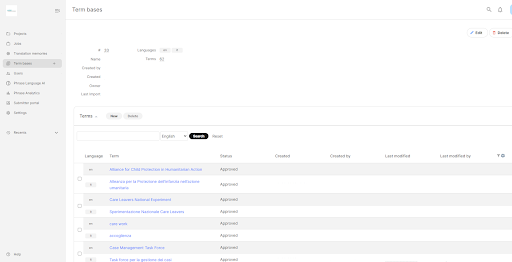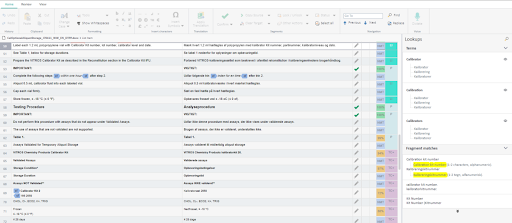Terminology management: What is it and how does it work
In the ever-evolving world of translation and localisation, one critical aspect is the need for accurate, consistent terminology. However, this is often more challenging than you may think because words and phrases rarely have a unique corresponding translation in the target language(s).
Whether your organisation uses brand-specific terminology or abbreviations, you operate in a highly regulated sector packed with industry-specific terms, or you have specific guidelines about translating or not product names, the language experts translating your materials need to know what these terms are. This is where terminology management comes into play.
A multilingual glossary or termbase enables translators to use the pre-established terms correctly and consistently throughout the text. In this blog post, we discuss terminology management, how it works and how you can benefit from it.

What is terminology management?
Terminology management is the process of identifying, defining, and managing a company’s or project’s terms that must be translated in a pre-established way. These terms could range from industry-specific jargon to personal preferences. The goal is to ensure that every term is used correctly and consistently across all translations, maintaining the integrity and quality of the content.
Creating a multilingual glossary with preferred translations is a good starting point. This glossary serves as a handy reference to maintain consistency and accuracy in translations. It typically includes a list of terms in one language and their preferred translations in another, ensuring that the same term is always translated in the same way.
Building on this idea, you can also create a termbase, which is more comprehensive. A termbase is a list of single words, phrases or expressions containing a source term with its corresponding target term in the target language and additional information about the terms, including images, notes, and definitions. For example, you can provide information about case-sensitivity rules or usage within context, such as buttons on an app or website.

Once the terms are approved, the termbase is normally used in a computer-assisted translation (CAT) tool that provides a repository of multilingual terms, reference notes, and usage rules agreed upon before the translation. It is worth pointing out that a termbase differs from a translation memory – another feature of most CAT tools – and you can leverage both solutions in your translation project.
Creating a termbase
Some popular CAT tools have different interfaces and functionalities for termbase creation and management, simplifying the creation of a new termbase. Users only need to decide on the languages they will include (for instance, English to Danish) and determine what information (such as term, definition, context or part of speech) each entry will contain.

Then, you just need to add the terms manually, along with their definitions and other relevant information. Alternatively, if you already have a list of terms, many CAT tools allow you to import them in bulk using formats like Excel or CSV.
How does a termbase work
Once you have created a termbase and it is integrated into your CAT tool, a termbase works in a very efficient and straightforward way:
- The termbase in the CAT tool automatically scans the source text and suggests terms from the termbase when they appear in the text you translate.
- Translators can easily see the pre-established terms and use the right terminology in the translation, eliminating the need to search for the correct terminology outside the CAT tool.

Benefits of using terminology management
Terminology management is not just a tool but a strategic asset in translation and localisation. It offers several advantages:
- Ensuring accuracy in translations: A well-maintained terminology database provides translators with a reliable reference, supporting them in using preferred terminology, enhancing the overall quality and reducing errors.
- Enhancing consistency and brand identity: It guarantees uniformity in terminology, aligning with client preferences across various projects and platforms. This consistency is crucial for maintaining brand identity and messaging coherence.
- Streamlining translation and localisation processes: Effective terminology management minimises the need for revisions and rework due to inconsistencies, saving significant time and effort for translators and editors.
The importance of terminology management
Terminology management is not just about creating a list of words. It is an intricate process that involves defining, managing, and consistently using a set of pre-established terms across multiple translations. This ensures accuracy and uniformity in how specific terms are translated, which is paramount in maintaining the integrity and quality of content and preserving brand identity and consistency.
If you are an organisation that values quality and consistency in its translations, adopting a solid terminology management strategy is essential. Don’t have the right expertise in-house to take care of it? Contact Ampere Translations to explore how we can help.
